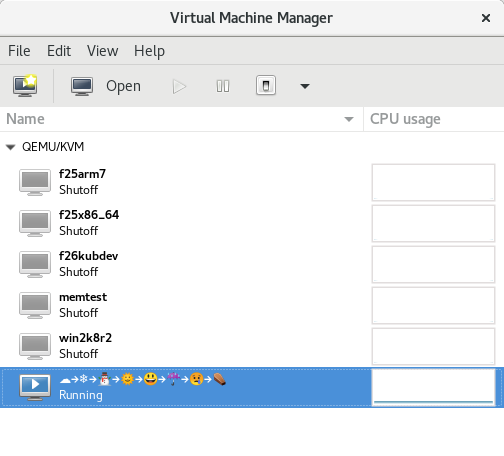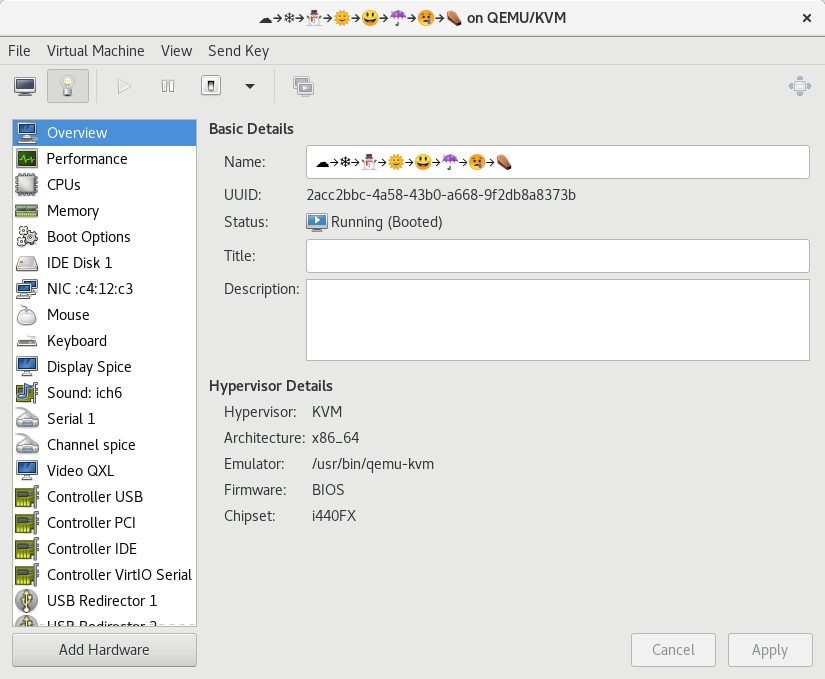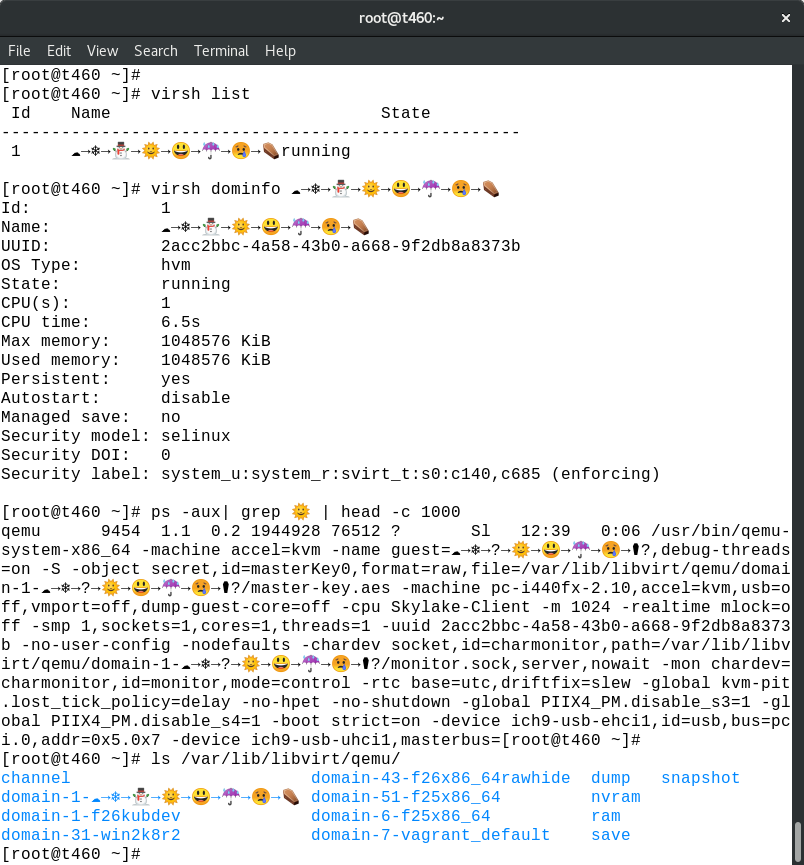Full coverage of libvirt XML schemas achieved in libvirt-go-xml
In recent times I have been aggressively working to expand the coverage of libvirt XML schemas in the libvirt-go-xml project. Today this work has finally come to a conclusion, when I achieved what I believe to be effectively 100% coverage of all of the libvirt XML schemas. More on this later, but first some background on Go and XML….
For those who aren’t familiar with Go, the core library’s encoding/xml module provides a very easy way to consume and produce XML documents in Go code. You simply define a set of struct types and annotate their fields to indicate what elements & attributes each should map to. For example, given the Go structs:
type Person struct {
XMLName xml.Name `xml:"person"`
Name string `xml:"name,attr"`
Age string `xml:"age,attr"`
Home *Address `xml:"home"`
Office *Address `xml:"office"`
}
type Address struct {
Street string `xml:"street"`
City string `xml:"city"`
}
You can parse/format XML documents looking like
<person name="Joe Blogs" age="24">
<home>
<street>Some where</street><city>London</city>
</home>
<office>
<street>Some where else</street><city>London</city>
</office>
</person>
Other programming languages I’ve used required a great deal more work when dealing with XML. For parsing, there’s typically a choice between an XML stream based parser where you have to react to tokens as they’re parsed and stuff them into structs, or a DOM object hierarchy from which you then have to pull data out into your structs. For outputting XML, apps either build up a DOM object hierarchy again, or dynamically format the XML document incrementally. Whichever approach is taken, it generally involves writing alot of tedious & error prone boilerplate code. In most cases, the Go encoding/xml module eliminates all the boilerplate code, only requiring the data type defintions. This really makes dealing with XML a much more enjoyable experience, because you effectively don’t deal with XML at all! There are some exceptions to this though, as the simple annotations can’t capture every nuance of many XML documents. For example, integer values are always parsed & formatted in base 10, so extra work is needed for base 16. There’s also no concept of unions in Go, or the XML annotations. In these edge cases custom marshaling / unmarshalling methods need to be written. BTW, this approach to XML is also taken for other serialization formats including JSON and YAML too, with one struct field able to have many annotations so it can be serialized to a range of formats.
Back to the point of the blog post, when I first started writing Go code using libvirt it was immediately obvious that everyone using libvirt from Go would end up re-inventing the wheel for XML handling. Thus about 1 year ago, I created the libvirt-go-xml project whose goal is to define a set of structs that can handle documents in every libvirt public XML schema. Initially the level of coverage was fairly light, and over the past year 18 different contributors have sent patches to expand the XML coverage in areas that their respective applications touched. It was clear, however, that taking an incremental approach would mean that libvirt-go-xml is forever trailing what libvirt itself supports. It needed an aggressive push to achieve 100% coverage of the XML schemas, or as near as practically identifiable.
Alongside each set of structs we had also been writing unit tests with a set of structs populated with data, and a corresponding expected XML document. The idea for writing the tests was that the author would copy a snippet of XML from a known good source, and then populate the structs that would generate this XML. In retrospect this was not a scalable approach, because there is an enourmous range of XML documents that libvirt supports. A further complexity is that Go doesn’t generate XML documents in the exact same manner. For example, it never generates self-closing tags, instead always outputting a full opening & closing pair. This is semantically equivalent, but makes a plain string comparison of two XML documents impractical in the general case.
Considering the need to expand the XML coverage, and provide a more scalable testing approach, I decided to change approach. The libvirt.git tests/ directory currently contains 2739 XML documents that are used to validate libvirt’s own native XML parsing & formatting code. There is no better data set to use for validating the libvirt-go-xml coverage than this. Thus I decided to apply a round-trip testing methodology. The libvirt-go-xml code would be used to parse the sample XML document from libvirt.git, and then immediately serialize them back into a new XML document. Both the original and new XML documents would then be parsed generically to form a DOM hierarchy which can be compared for equivalence. Any place where documents differ would cause the test to fail and print details of where the problem is. For example:
$ go test -tags xmlroundtrip
--- FAIL: TestRoundTrip (1.01s)
xml_test.go:384: testdata/libvirt/tests/vircaps2xmldata/vircaps-aarch64-basic.xml: \
/capabilities[0]/host[0]/topology[0]/cells[0]/cell[0]/pages[0]: \
element in expected XML missing in actual XML
This shows the filename that failed to correctly roundtrip, and the position within the XML tree that didn’t match. Here the NUMA cell topology has a ‘<pages>‘ element expected but not present in the newly generated XML. Now it was simply a matter of running the roundtrip test over & over & over & over & over & over & over……….& over & over & over, adding structs / fields for each omission that the test identified.
After doing this for some time, libvirt-go-xml now has 586 structs defined containing 1816 fields, and has certified 100% coverage of all libvirt public XML schemas. Of course when I say 100% coverage, this is probably a lie, as I’m blindly assuming that the libvirt.git test suite has 100% coverage of all its own XML schemas. This is certainly a goal, but I’m confident there are cases where libvirt itself is missing test coverage. So if any omissions are identified in libvirt-go-xml, these are likely omissions in libvirt’s own testing.
On top of this, the XML roundtrip test is set to run in the libvirt jenkins and travis CI systems, so as libvirt extends its XML schemas, we’ll get build failures in libvirt-go-xml and thus know to add support there to keep up.
In expanding the coverage of XML schemas, a number of non-trivial changes were made to existing structs defined by libvirt-go-xml. These were mostly in places where we have to handle a union concept defined by libvirt. Typically with libvirt an element will have a “type” attribute, whose value then determines what child elements are permitted. Previously we had been defining a single struct, whose fields represented all possible children across all the permitted type values. This did not scale well and gave the developer no clue what content is valid for each type value. In the new approach, for each distinct type attribute value, we now define a distinct Go struct to hold the contents. This will cause API breakage for apps already using libvirt-go-xml, but on balance it is worth it get a better structure over the long term. There were also cases where a child XML element previously represented a single value and this was mapped to a scalar struct field. Libvirt then added one or more attributes on this element, meaning the scalar struct field had to turn into a struct field that points to another struct. These kind of changes are unavoidable in any nice manner, so while we endeavour not to gratuitously change currently structs, if the libvirt XML schema gains new content, it might trigger further changes in the libvirt-go-xml structs that are not 100% backwards compatible.
Since we are now tracking libvirt.git XML schemas, going forward we’ll probably add tags in the libvirt-go-xml repo that correspond to each libvirt release. So for app developers we’ll encourage use of Go vendoring to pull in a precise version of libvirt-go-xml instead of blindly tracking master all the time.


